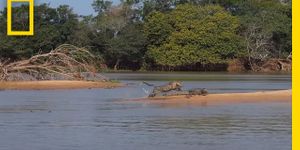Videos
Skilled hunter
MAR 19, 2015 9:40 AM PDT
Share
Modeling how cells move together could inspire self-healing materials
A paper published yesterday in Nature's Scientific Reports by a team led by physicist Igor Aronson of the U.S. Department of Energy's Argonne National Laboratory modeled the motion of cells moving together. Their findings may help scientists design new technologies inspired by nature, such as self-healing materials in batteries and other devices.

Aronson has long been interested in how very small bodies move-the principles that govern their motion, especially in crowds, can be very different than principles at the macro scale.
Cells frequently migrate en masse-to the site of a wound, say, to do a quick patch job on the skin-but the dynamics of how they do so are not fully understood.
Aronson and his colleagues created a model of about 100 cells and investigated how the cells spontaneously began to migrate, based on collisions with one another. As they collided, the cells began to move at the same speed and formed into coherent, traveling flocks.
The team wanted to see how movement changed as they varied how much the cells stuck to one another (called adhesion), how fast they were moving and how stiff the cells and surrounding tissue were. Each combination changed how the cells behaved.
When adhesion was high, cells formed large moving mats resembling living tissues; with moderate adhesion, they formed smaller clusters that broke up and reformed constantly, limiting the collective motion. At low adhesion, it took many collisions before the cells began to travel loosely together, like a school of fish.
"This also suggests ways that cells can solve complex navigation problems, by sensing how stiff and how sticky the substrate they are moving on is," Aronson said.
"These approaches can inform how we go about designing self-healing materials," he said. Scientists are very interested in creating ways for complex devices, like batteries, to have built-in methods of repairing cracks in the electrodes. (In one approach, tiny capsules full of metal can burst open in response to mechanical stress and fill in cracks.) For example, particles could be designed with particular stiffness and adhesion to move quickly or form groups of different sizes; or particles could be guided to destinations by stamping surfaces with adhesive patterns.
The study, "Collisions of deformable cells lead to collective migration," was supported by the U.S. Department of Energy's Office of Science, Office of Basic Energy Sciences, Materials Engineering Division, and by the German Science Foundation. The other authors of this work are Falko Ziebert with the University of Freiburg and Jakob Löber with the Technical University of Berlin in Germany.
Source: phys.org

Aronson has long been interested in how very small bodies move-the principles that govern their motion, especially in crowds, can be very different than principles at the macro scale.
Cells frequently migrate en masse-to the site of a wound, say, to do a quick patch job on the skin-but the dynamics of how they do so are not fully understood.
Aronson and his colleagues created a model of about 100 cells and investigated how the cells spontaneously began to migrate, based on collisions with one another. As they collided, the cells began to move at the same speed and formed into coherent, traveling flocks.
The team wanted to see how movement changed as they varied how much the cells stuck to one another (called adhesion), how fast they were moving and how stiff the cells and surrounding tissue were. Each combination changed how the cells behaved.
When adhesion was high, cells formed large moving mats resembling living tissues; with moderate adhesion, they formed smaller clusters that broke up and reformed constantly, limiting the collective motion. At low adhesion, it took many collisions before the cells began to travel loosely together, like a school of fish.
"This also suggests ways that cells can solve complex navigation problems, by sensing how stiff and how sticky the substrate they are moving on is," Aronson said.
"These approaches can inform how we go about designing self-healing materials," he said. Scientists are very interested in creating ways for complex devices, like batteries, to have built-in methods of repairing cracks in the electrodes. (In one approach, tiny capsules full of metal can burst open in response to mechanical stress and fill in cracks.) For example, particles could be designed with particular stiffness and adhesion to move quickly or form groups of different sizes; or particles could be guided to destinations by stamping surfaces with adhesive patterns.
The study, "Collisions of deformable cells lead to collective migration," was supported by the U.S. Department of Energy's Office of Science, Office of Basic Energy Sciences, Materials Engineering Division, and by the German Science Foundation. The other authors of this work are Falko Ziebert with the University of Freiburg and Jakob Löber with the Technical University of Berlin in Germany.
Source: phys.org
You May Also Like
Loading Comments...








